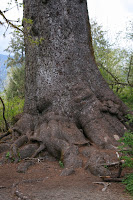
Olympic National Parks 48 miles of wilderness coastline includes many secluded beaches, but a few of them are have relatively close access from roads. Third Beach is 1.6 miles from La Push Road west of Forks. The trail had surprisingly large trees, both hemlock and sitka spruce.
I can be reached via a super freeway of a trail from beginning to end. The final quarter mile drops about 200 feet down a drainage which empties on the beach. It is also a good source of water for the longer 17 mile hike down the south coast wilderness to Oil City and the Hoh River drainage.
 Looking south on Third Beach show an impassable headland that an overland trail must solve.
Looking south on Third Beach show an impassable headland that an overland trail must solve.My recent hike to Third Beach found a pair backpackers camped behind a rock on the small beach. That evening found a mild high tide and a rough surf which amounted to limited space on the beach. Waves lapped the 36 inch plateau where their tent was located and wetted my boots as I looked for the southern exit from the beach.
 Large Sitka Spruce and Hemlock trees highlight the trail to Third Beach.A thin waterfall drops from the headland to the crashing surf below on the south side of Third Beach.
Large Sitka Spruce and Hemlock trees highlight the trail to Third Beach.A thin waterfall drops from the headland to the crashing surf below on the south side of Third Beach.A trail departs from the over the headland to the next beach to the south. Using the beach as an overnight camp is permitted, but permits are necessary through the Olympic National Park Wilderness Information Center or the various locations throughout the park.


.jpg)






